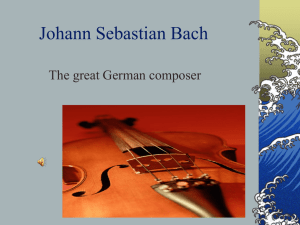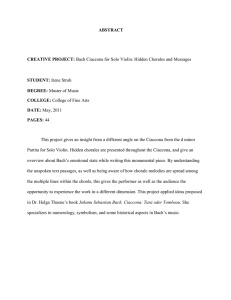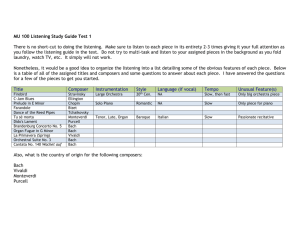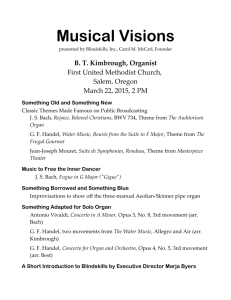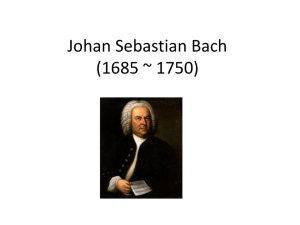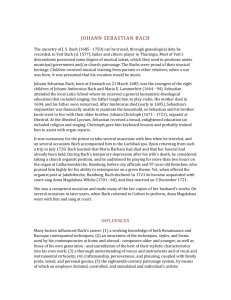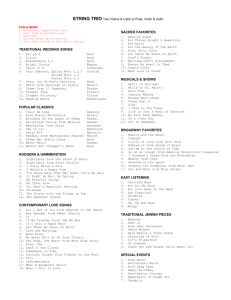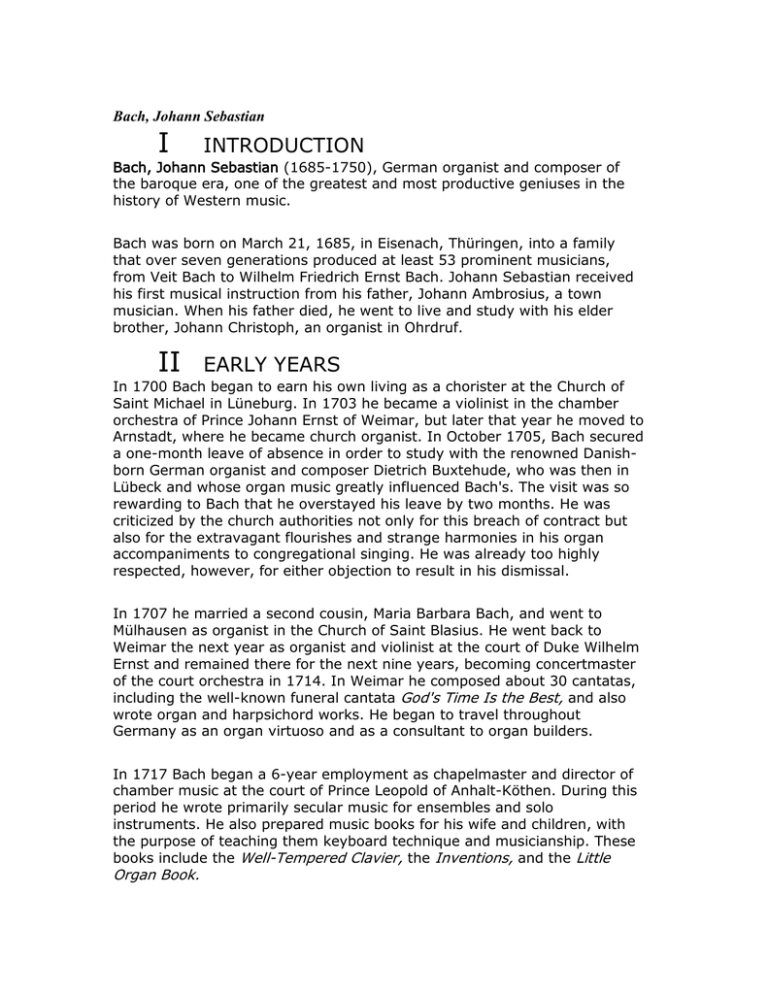
Bach, Johann Sebastian
I
INTRODUCTION
Bach, Johann Sebastian (1685-1750), German organist and composer of
the baroque era, one of the greatest and most productive geniuses in the
history of Western music.
Bach was born on March 21, 1685, in Eisenach, Thüringen, into a family
that over seven generations produced at least 53 prominent musicians,
from Veit Bach to Wilhelm Friedrich Ernst Bach. Johann Sebastian received
his first musical instruction from his father, Johann Ambrosius, a town
musician. When his father died, he went to live and study with his elder
brother, Johann Christoph, an organist in Ohrdruf.
II
EARLY YEARS
In 1700 Bach began to earn his own living as a chorister at the Church of
Saint Michael in Lüneburg. In 1703 he became a violinist in the chamber
orchestra of Prince Johann Ernst of Weimar, but later that year he moved to
Arnstadt, where he became church organist. In October 1705, Bach secured
a one-month leave of absence in order to study with the renowned Danishborn German organist and composer Dietrich Buxtehude, who was then in
Lübeck and whose organ music greatly influenced Bach's. The visit was so
rewarding to Bach that he overstayed his leave by two months. He was
criticized by the church authorities not only for this breach of contract but
also for the extravagant flourishes and strange harmonies in his organ
accompaniments to congregational singing. He was already too highly
respected, however, for either objection to result in his dismissal.
In 1707 he married a second cousin, Maria Barbara Bach, and went to
Mülhausen as organist in the Church of Saint Blasius. He went back to
Weimar the next year as organist and violinist at the court of Duke Wilhelm
Ernst and remained there for the next nine years, becoming concertmaster
of the court orchestra in 1714. In Weimar he composed about 30 cantatas,
including the well-known funeral cantata God's Time Is the Best, and also
wrote organ and harpsichord works. He began to travel throughout
Germany as an organ virtuoso and as a consultant to organ builders.
In 1717 Bach began a 6-year employment as chapelmaster and director of
chamber music at the court of Prince Leopold of Anhalt-Köthen. During this
period he wrote primarily secular music for ensembles and solo
instruments. He also prepared music books for his wife and children, with
the purpose of teaching them keyboard technique and musicianship. These
books include the Well-Tempered Clavier, the Inventions, and the Little
Organ Book.
Bach's first wife died in 1720, and the next year he married Anna
Magdalena Wilcken, a fine singer and daughter of a court musician. She
bore him 13 children in addition to the 7 he had had by his first wife, and
she helped him in his work by copying the scores of his music for the
performers.
III
LATER YEARS
Bach moved to Leipzig in 1723 and spent the rest of his life there. His
position as musical director and choirmaster of Saint Thomas's Church and
church school in Leipzig was unsatisfactory in many ways. He squabbled
continually with the town council, and neither the council nor the populace
appreciated his musical genius. They saw in him little more than a stuffy
old man who clung stubbornly to obsolete forms of music. Nonetheless, the
202 cantatas surviving from the 295 that he wrote in Leipzig are still played
today, whereas much that was new and in vogue at the time has been
forgotten. Most of the cantatas open with a section for chorus and
orchestra, continue with alternating recitatives and arias for solo voices and
accompaniment, and conclude with a chorale based on a simple Lutheran
hymn. The music is at all times closely bound to the text, ennobling the
latter immeasurably with its expressiveness and spiritual intensity. Among
these works are the Ascension Cantata and the Christmas Oratorio, the
latter consisting of six cantatas. The St. John Passion and the St. Matthew
Passion also were written in Leipzig, as was the epic Mass in B Minor.
Among the works written for the keyboard during this period are the
famous Goldberg Variations; Part II of the Well-Tempered Clavier; and the
Art of the Fugue, a magnificent demonstration of his contrapuntal skill in
the form of 16 fugues and 4 canons, all on a single theme. Bach's sight
began to fail in the last year of his life, and he died on July 28, 1750, after
undergoing an unsuccessful eye operation.
IV
THE BACH REVIVAL
After Bach's death he was remembered less as a composer than as an
organist and harpsichord player. His frequent tours had ensured his
reputation as the greatest organist of the time, but his contrapuntal style of
writing sounded old-fashioned to his contemporaries, most of whom
preferred the new preclassical styles then coming into fashion, which were
more homophonic in texture and less contrapuntal than Bach's music.
Consequently, for the next 80 years his music was neglected by the public,
although a few musicians admired it, among them Wolfgang Amadeus
Mozart and Ludwig van Beethoven. A revival of interest in Bach's music
occurred in the mid-19th century. The German composer Felix Mendelssohn
arranged a performance of the St. Matthew Passion in 1829, which did
much to awaken popular interest in Bach. The Bach Gesellschaft, formed in
1850, devoted itself assiduously to finding, editing, and publishing Bach's
works.
Because the “Bach revival” coincided with the flowering of the romantic
movement in music, performance styles were frequently gross distortions
of Bach's intentions. Twentieth-century scholarship, inspired by the early
enthusiasm of German-born Protestant medical missionary, organist, and
musicologist Albert Schweitzer, gradually has unearthed principles of
performance that are truer to Bach's era and his music.
Bach was largely self-taught in musical composition. His principal study
method, following the custom of his day, was to copy in his workbooks the
music of French, German, and Italian composers of his own time and
earlier. He did this throughout his life and often made arrangements of
other composers' works.
V
MASTER OF COUNTERPOINT
The significance of Bach's music is due in large part to the scope of his
intellect. He is perhaps best known as a supreme master of counterpoint.
He was able to understand and use every resource of musical language that
was available in the baroque era. Thus, if he chose, he could combine the
rhythmic patterns of French dances, the gracefulness of Italian melody, and
the intricacy of German counterpoint all in one composition. At the same
time he could write for voice and the various instruments so as to take
advantage of the unique properties of construction and tone quality in each.
In addition, when a text was associated with the music, Bach could write
musical equivalents of verbal ideas, such as an undulating melody to
represent the sea, or a canon to describe the Christians following the
teaching of Jesus.
Bach's ability to assess and exploit the media, styles, and genre of his day
enabled him to achieve many remarkable transfers of idiom. For instance,
he could take an Italian ensemble composition, such as a violin concerto,
and transform it into a convincing work for a single instrument, the
harpsichord. By devising intricate melodic lines, he could convey the
complex texture of a multivoiced fugue on a single-melody instrument,
such as the violin or cello. The conversational rhythms and sparse textures
of operatic recitatives can be found in some of his works for solo keyboard.
Technical facility alone, of course, was not the source of Bach's greatness.
It is the expressiveness of his music, particularly as manifested in the vocal
works, that conveys his humanity and that touches listeners everywhere.
Contributed By:
Wilfrid Mellers
1
1"Bach, Johann Sebastian."Microsoft® Encarta® Encyclopedia 2001. © 1993-2000
Microsoft Corporation. All rights reserved.

